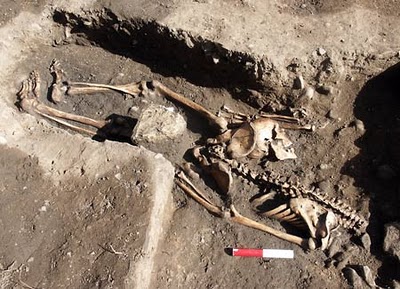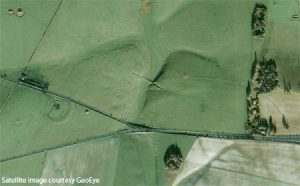 In the past few months, archaeologist have excavated an exceptionally well preserved urn field at Wijnegem in the province of Antwerp, Belgium.An urn field is a cemetery, where in cremation remains were placed in an urn into the soil. About 24 graves from the early Iron Age (ca.2800 years old) were examined. Circular ditches point to graves belonging to persons with a higher social status. That the graves are this well preserved, we partly thank to the fact that the site has been used as agricultural area since the early Middle Ages, and the preservation under 150 years old European Beeches.
In the past few months, archaeologist have excavated an exceptionally well preserved urn field at Wijnegem in the province of Antwerp, Belgium.An urn field is a cemetery, where in cremation remains were placed in an urn into the soil. About 24 graves from the early Iron Age (ca.2800 years old) were examined. Circular ditches point to graves belonging to persons with a higher social status. That the graves are this well preserved, we partly thank to the fact that the site has been used as agricultural area since the early Middle Ages, and the preservation under 150 years old European Beeches.
At the end of 2007, the Heritage department of the Province Antwerp on request of POM-Antwerp created multiple test slots in between the beeches on the parcel. This because of the development of “Den Hoek 3” as an area for light industry use. Because the preliminary examination pointed to a well preserved urn field, POM-Antwerp hired 4 archaeologist to examine the area. Next to the urn field – which spans an area of 1 hectare – the whole site contains traces of a settlement from the late Iron Age /Early Roman period.
 The urns are relatively well preserved and were removed from the pits they were buried in 2800 years ago almost undamaged. A few of them were hit by ploughs during the early Middle Ages. The graves that are surrounded by a circle pit, are suspected to belong to person of high social status.For these persons often a tomb existing of a circle ditch, or less frequent, an elips shaped long bed, with sometimes a few poles and probably also a mound was constructed. Graves located under a mound were often not digged in, which lead to them being destroyed together with the hills by ploughing.Yet, the archaeologist found 2 urns in a circle ditch.The other circle pits had no central grave left. Some of the graves contained burial gifts, a small jar.In 2 cases, a skeleton was added separately to the pit. Besides that no skeleton remains were found.As the parts that were recovered seem to be deliberately placed, those are explained as part of the funeral ritual.
The urns are relatively well preserved and were removed from the pits they were buried in 2800 years ago almost undamaged. A few of them were hit by ploughs during the early Middle Ages. The graves that are surrounded by a circle pit, are suspected to belong to person of high social status.For these persons often a tomb existing of a circle ditch, or less frequent, an elips shaped long bed, with sometimes a few poles and probably also a mound was constructed. Graves located under a mound were often not digged in, which lead to them being destroyed together with the hills by ploughing.Yet, the archaeologist found 2 urns in a circle ditch.The other circle pits had no central grave left. Some of the graves contained burial gifts, a small jar.In 2 cases, a skeleton was added separately to the pit. Besides that no skeleton remains were found.As the parts that were recovered seem to be deliberately placed, those are explained as part of the funeral ritual.
In total 24 graves, of which 12 contain urns, have been discovered.What’s inside the urns is not known, as they weren’t opened yet. They will be send to a laboratory where a physical antropologist shall examine the skeleton remains and age, gender and possible causes of death or illnesses will be determined. It’s very well possible that more burial gifts will be found inside the urns, amongst those metal objects. Based on the shape of the urns and their decorations, the burial field is dated during the early Iron Age.During the next few months, this dating will be refined by the use of 14C-dating on the charcoal samples.
 It’s most likely that 7 centuries later (100 BC) an agricultural settlement was founded in the area.In the years 1950 to 1960 many traces were lost without being documented because of the removal of large amounts of sand. This is when a few wells from the late Iron Age / early Roman period surfaced. At the excavation site, archaeologist registered already as much as 4 maps of houses and a well. Remarkable is that this concerns very long houses, up to 28 meters in length. There are 3 wells matching these houses, probably only two of these large houses existed simultaneously in this spot.
It’s most likely that 7 centuries later (100 BC) an agricultural settlement was founded in the area.In the years 1950 to 1960 many traces were lost without being documented because of the removal of large amounts of sand. This is when a few wells from the late Iron Age / early Roman period surfaced. At the excavation site, archaeologist registered already as much as 4 maps of houses and a well. Remarkable is that this concerns very long houses, up to 28 meters in length. There are 3 wells matching these houses, probably only two of these large houses existed simultaneously in this spot.
After this, the parcels were used as fields for agriculture.Proof for this are ploughing traces and the construction of small canals. This agricultural development during the Middle Ages caused a added amount of manure from stables, causing the coating to become more thick.150 years ago beeches were planted, safeguarding the burial site and settlement free from further disturbing.
This archaeological examination is being completed and the findings will get a place in the Provincial Archaeological Museum. “The new street names on the site will be a lasting memory to this urn field”, decided the local officials.
Via archeonet. (Dutch)
Photographs & source: Province Antwerp (Dutch)



